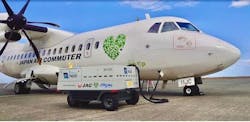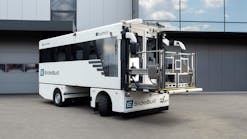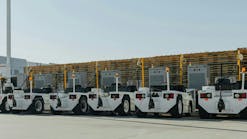Electric ground support equipment (eGSE) is seen as a main contributor to improve the sustainability of aircraft ground handling. Several options are available for eGSE, but this type of equipment also has specific requirements.
eGSE is available in many options. Electric equipment provides advantages but comes with infrastructural requirements.
Important Contributor
A clear advantage of electric GSE over its internal combustion engine (ICE) variant is the net impact of Scope 1 and 2 emissions, affirms Tan Yen Ling, head of group sustainability at SATS.
“With the electrification of SATS’s baggage tractors in Singapore, for example, there is an approximately 5-percent improvement in carbon intensity for flight handling between 2019 and 2023,” she says. “Furthermore, with no tailpipe fumes and reduced noise pollution, electrification of our vehicle fleet can create a healthier working environment for our workers, particularly for workspaces such as warehouses and baggage handling areas.”
Electric GSE is deemed important to improve sustainability but, highlights Charles Galloway, dnata’s regional CEO, airport operations – Asia Pacific, dnata understands that electrification is not the only solution to its ground handling fleet strategy, and that a mix of equipment types, including biodiesel, electric, hydrogen and hybrid must be considered.
“Some GSE types may be a better solution than others depending on the airport’s climatic conditions, GSE types and available infrastructure. We continue to support our global airport partners to prepare the infrastructure for further electrification,” he says.
eGPUs
Diesel ground power units (GPUs) have high fuel consumption since they need large diesel engines to run at relatively high engine speeds to generate 400 Hz power to an aircraft, which typically does not draw high load from the GPU.
This means a diesel powered GPU emits high CO₂ and NOₓ emissions, high noise levels and have high losses, observes Steven Ng, sales director at ITW GSE Asia Pacific.
“An eGPU is a zero-emission alternative that uses battery power instead of conventional diesel, meaning it is practically clean, extremely low noise and highly efficient. Customers often highlight the near-silence, the environmental friendliness and the low total cost of ownership, as major advantages of the eGPU,” he says. “When one puts the power on the aircraft, the ground crew can talk to each other even when they are near the eGPU. This also improves ground safety because the communication between the ground crew is clear.”
Typical 400 Hz GPUs can require a large amount of energy to deliver power over the entire period of aircraft turnaround or during aircraft maintenance, affirms Ng.
“This makes the eGPU a game changer in aircraft ground handling because, for example, replacing one diesel GPU with one of our eGPUs reduces CO₂ emissions by around 90 percent and NOₓ emissions by around 95 percent,” he says. “The harmful health effects of both CO2 and NOₓ emissions are becoming a major concern, and since an eGPU emits no CO2 and NOₓ into its operating environment, it can contribute significantly to a cleaner and safer working environment for the ground handlers. This also means that the eGPU can be a valuable solution to be used both inside and outside the hangar for MRO operations.”
Thanks to the lack of moving parts, the eGPU is less vulnerable to wear and tear, affirms Ng.
“This makes maintenance costs almost non-existent and the overall operating costs very low compared to a conventional diesel GPU. In fact, the running cost of our eGPU is around 20 percent or less compared to a diesel GPU, depending on electricity and fuel costs. The total cost of ownership (TCO) of our eGPU is typically lower than a diesel GPU after two years,” he says.
Electric Pushbacks
Malaysia’s AeroDarat was the first ground handling company in Asia to operate the remote-controlled electric pushback Mototok Spacer 8600NG, affirms Mohamad Khairi Ngadiran of project management office of AeroDarat.
“With the full implementation of the Malaysia Airlines narrow-body fleet in October 2024, we aim to reduce the carbon footprint by 10 tonnes per year. The major advantages of the implementation are staff efficiency to conduct pushback activity using a one-man operation, improve efficiency as the equipment is positioned to specifically serve a dedicated bay, hence reducing the waiting time of pushback equipment, and ensuring clean equipment movement and less maintenance cost,” he says.
“Nevertheless, infrastructure readiness and parking space will be the main challenges. The temporary solution plan on installation is in the pipeline by the airport operator with whom we work closely, and we hope this will not become a showstopper for us to pursue a more sustainable operation,” Ngadiran added.
Infrastructure Requirements
Some airports frequently experience peak load periods with a consumption level very close to the maximum power grid capacity of the airport, observes Ng.
“Increasing the grid capacity requires huge investments in infrastructure and it is very disruptive to operational airports. Having eGPUs a part of the airport’s electrical infrastructure allows one to smooth out the capacity demands over a 24-hour period by charging the eGPUs during periods of low power demand and contribute to a higher utilization rate of the existing grid capacity in the airport,” he says.
There are currently no universal standards in eGSE chargers, different eGSE may require different charger types potentially posing some challenges to airports trying to implement eGSE, according to Ng.
“Another common challenge is that some airports may find themselves lacking eGSE chargers, largely due to the limitation of existing grid capacity. However, most electric GPUs installed in the airports have excess electrical capacity at the input as most aircraft do not draw full load from the GPU on average,” he says. “We have recently introduced a new product to exploit this excess grid capacity. The ITW GSE Power Share technology ensures that the power from the grid to the electric GPUs can be shared and utilised efficiently for other applications, such as to power up a 50/60Hz AC-powered equipment, or charge the eGSE.”
The electric GPU with Power Share technology allows the 50/60Hz AC-equipment to be powered up even when the GPU is supplying 400Hz power to the aircraft at the same time, explains Ng.
“This unique Power Share technology allows load sharing capability and is designed to ensure that the 400Hz power to the aircraft is prioritised and without any interruption to the aircraft,” he says.
Today’s airports want to modernize and enhance their gate capabilities but may find their options limited by existing electrical infrastructure, affirms Ng.
“Airports are interested in upgrading their existing gate equipment, but often face constraints due to limited power capacity and high costs associated with upgrading their current electrical infrastructure,” he says. “The typical electric GPUs and PCAs, are designed to handle peak loads conditions, which results in around 35-50 percent excess capacity on average. The ITW GSE EcoGate solution can effectively use this surplus capacity to power additional equipment or upgrade existing equipment, without the need to upgrade the existing electrical infrastructure. This technology prioritizes the power demand from the GPUs and ensures that the total power consumption does not exceed a predetermined limit at the gate. This allows improved utilization of the existing grid capacity in the airport without affecting the performance of the gate equipment.”
According to Tan, several limitations exist such as battery technology and infrastructure readiness.
“Heavy duty and long-distance transport vehicles that require batteries with high energy density may not be operationally or financially feasible in the near term. Further to this, the cost and lead time to upgrade infrastructure can slow the adoption of electric GSE,” she says. “A significant investment was made by WFS, a member of the SATS Group, between 2020-2022 to upgrade the CDG Cargo Zone electrical infrastructure to cope with the increased charging needs as electric forklifts came online.”
While electrification presents an opportunity to source renewable electricity, some markets may have lower access to renewable energy infrastructure solutions, points out Tan.
“Regulations or policies applicable on public roads may, in certain jurisdictions, not be applicable to the unique airside environment. Introducing or enhancing regulations or policies will help to incentivise and/or accelerate the transition to electric vehicles,” she concludes.










